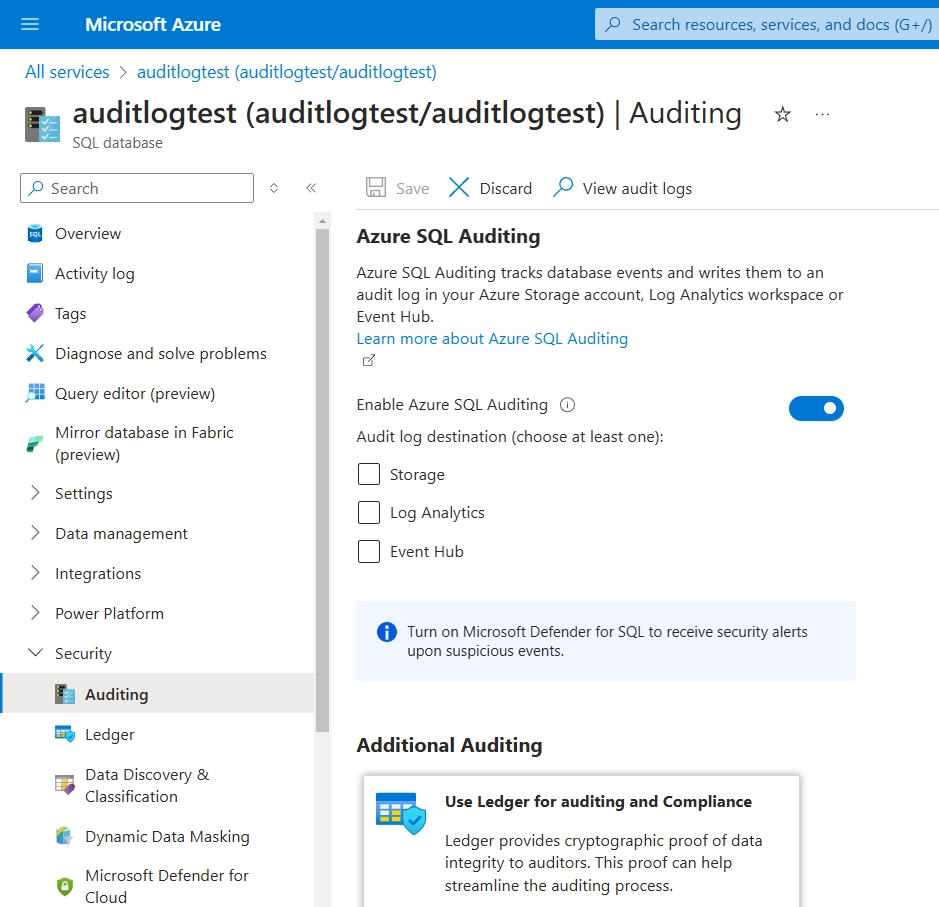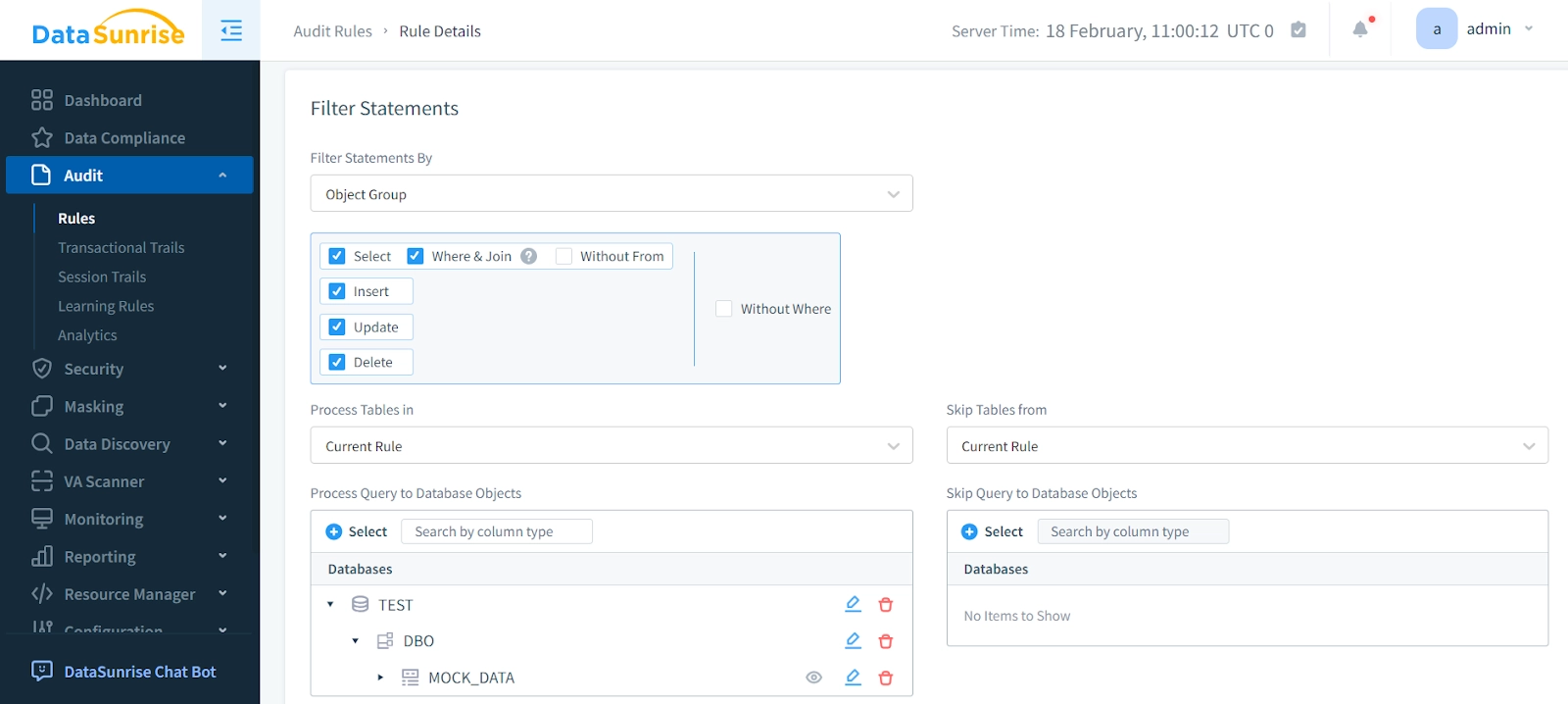Azure SQL Database Audit Log
In today’s dynamic cybersecurity landscape, implementing robust audit logs for Azure SQL Database has become critical for organizations managing sensitive data in cloud environments. According to Fortinet’s 2025 Global Threat Report, database-related security incidents increased by 54% over the past year, with inadequate audit logging identified as a contributing factor in 71% of these breaches. This highlights the essential role of comprehensive audit log solutions for modern database platforms like Azure SQL.
As organizations continue to migrate mission-critical workloads to the cloud, maintaining detailed audit logs of database activities provides the visibility needed to ensure security and maintain compliance. Microsoft Azure SQL Database offers powerful native audit log capabilities that allow organizations to track database activities effectively while supporting both security monitoring and regulatory requirements.
What is an Azure SQL Database Audit Log?
An Azure SQL Database audit log is a comprehensive record of database events that captures who accessed data, what actions they performed, when these actions occurred, and which database objects were affected. This systematic logging serves multiple essential functions:
- Security Monitoring: Detecting unauthorized access attempts, suspicious query patterns, and potential database threats
- Compliance Documentation: Meeting requirements for regulatory frameworks like GDPR, HIPAA, SOX, and PCI DSS
- Forensic Investigation: Providing detailed evidence for security incident analysis and breach investigations
- Operational Insights: Understanding database activity history and identifying optimization opportunities
- Access Accountability: Ensuring users are held accountable for their database interactions
Unlike traditional on-premises databases that often require extensive configuration, Azure SQL Database streamlines audit log implementation through built-in features that can be enabled with minimal setup while providing robust logging functionality.
Native Azure SQL Database Audit Log Capabilities
Azure SQL Database includes comprehensive native audit log features that can be configured through multiple interfaces including the Azure portal, PowerShell, Azure CLI, or T-SQL commands.
1. Types of Audit Logging in Azure SQL
Azure SQL Database offers two primary approaches to audit logging:
- SQL Database Auditing: The standard auditing feature that records database events to Azure Storage, Log Analytics workspace, or Event Hub
- Extended Events Auditing: More granular auditing leveraging SQL Server’s extended events architecture for detailed activity capture
2. Enabling Azure SQL Database Audit Logs
Azure Portal Configuration:
- Navigate to your Azure SQL server or database in the Azure portal
- Select “Auditing” under the Security section
- Set “Enable Azure SQL Database auditing” to “ON”
- Configure your audit log destination (Azure Storage, Log Analytics, or Event Hub)
- Define the retention period for audit records
- Select the audit action groups to monitor
- Save your configuration

3. Key Azure SQL Audit Log Events
Azure SQL Database audit logs can capture a wide range of database events, including:
| Event Category | Description | Example Events |
|---|---|---|
| Database Authentication | User login attempts | Successful/failed logins |
| Data Access | Data retrieval operations | SELECT statements |
| Data Modification | Changes to database content | INSERT, UPDATE, DELETE |
| Schema Changes | Alterations to database structure | CREATE, ALTER, DROP |
| Permission Changes | Security permission modifications | GRANT, DENY, REVOKE |
| Administrative Actions | Database management operations | BACKUP, RESTORE |
Example audit log entry:
{
"event_time": "2025-01-18T15:42:36.5170068Z",
"sequence_number": 1,
"action_id": "SELECT",
"succeeded": true,
"permission_check_result": "SUCCESS",
"server_principal_id": 8372,
"server_principal_name": "finance_analyst@contoso.com",
"database_principal_name": "db_datareader",
"database_name": "FinancialReporting",
"schema_name": "dbo",
"object_name": "AnnualReports",
"statement": "SELECT * FROM dbo.AnnualReports WHERE FiscalYear = 2024",
"client_ip": "40.112.128.75",
"application_name": "Power BI"
}
Sample audit log records:
| event_time | action_id | server_principal_name | database_name | object_name | client_ip |
|---|---|---|---|---|---|
| 2025-01-18 15:42:36 | SELECT | finance_analyst@contoso.com | FinancialReporting | AnnualReports | 40.112.128.75 |
| 2025-01-18 15:40:12 | UPDATE | app_service | CustomerDB | Accounts | 13.91.124.56 |
| 2025-01-18 15:35:27 | FAILED_LOGIN | unknown_user | master | – | 104.42.18.92 |
| 2025-01-18 15:32:05 | CREATE_TABLE | db_admin@contoso.com | ProductCatalog | Products | 52.187.30.45 |
| 2025-01-18 15:28:14 | DROP_TABLE | db_admin@contoso.com | ArchiveDB | OldTransactions | 52.187.30.45 |
4. Accessing and Analyzing Azure SQL Audit Logs
Azure SQL Database audit logs can be accessed and analyzed through multiple methods:
- Azure Portal: Navigate to your SQL server or database, select “Auditing,” and click “View audit logs” to browse and filter logged events
- Azure Storage Explorer: For logs stored in Azure Blob Storage, use Storage Explorer to browse and download log files
- Log Analytics Queries: For logs sent to Log Analytics, use KQL (Kusto Query Language) for advanced analysis:
// Find all failed login attempts in the last 24 hours AzureDiagnostics | where Category == "SQLSecurityAuditEvents" | where TimeGenerated > ago(24h) | where action_id_s == "FAILED_LOGIN" | project TimeGenerated, server_principal_name_s, client_ip_s, application_name_s | order by TimeGenerated desc
- PowerShell: Retrieve and analyze audit records programmatically:
# Get audit records for a specific time period Get-AzSqlDatabaseAudit -ResourceGroupName "Financial-RG" ` -ServerName "finance-sql-east" ` -DatabaseName "Transactions" ` -StartTime (Get-Date).AddDays(-1) ` -EndTime (Get-Date)
Enhanced Azure SQL Audit Logging with DataSunrise
For organizations requiring more comprehensive audit log capabilities, DataSunrise Database Security Suite offers advanced features that extend Azure SQL Database’s native logging functionality.
Setting Up DataSunrise for Azure SQL Database
Implementing DataSunrise for enhanced audit logging involves a straightforward process:
- Connect to Your Azure SQL Database: Add your Azure SQL Database instance to DataSunrise by specifying connection details and configuring authentication using SQL credentials or Azure AD integration.
- Configure Audit Rules: Define specific tables and operations to monitor, create custom rules for sensitive data, and configure compliance-specific audit requirements.
- Monitor Audit Logs: Access the “Transactional Trails” dashboard to view detailed event information, filter logs based on various criteria, and generate comprehensive reports.

Key Advantages of DataSunrise for Azure SQL Audit Logging
1. Comprehensive Audit Rules
DataSunrise offers granular control over audit logging through customizable rules based on user identities and roles, application contexts, database objects and operations, time periods and access patterns, and query content and complexity. This flexibility allows organizations to implement precise audit policies that capture critical security events while minimizing noise from routine operations.
2. Real-Time Monitoring and Alerting
Unlike basic logging systems, DataSunrise provides immediate visibility into database activity monitoring through live session monitoring with detailed contextual information. The platform delivers real-time notifications for suspicious or unauthorized operations via configurable notification channels including email, Slack, and MS Teams. Organizations benefit from threshold-based alerting for anomalous access patterns, enabling rapid response to potential security incidents.
3. Advanced Security Analytics
DataSunrise employs sophisticated analytics to transform raw audit data into actionable security insights. The system performs user behavior analysis to establish normal activity baselines while utilizing anomaly detection to identify deviations from expected patterns. Security teams gain advantage from risk scoring based on multiple contextual factors and correlation of events to detect sophisticated attack patterns that might evade simpler monitoring systems.
4. Automated Compliance Reporting
DataSunrise streamlines regulatory compliance through pre-configured templates for GDPR, HIPAA, SOX, PCI DSS, and other regulations. The platform supports scheduled report generation for audit evidence, customizable compliance dashboards for specific requirements, and gap analysis to identify potential compliance deficiencies. This comprehensive approach significantly reduces the manual effort typically required for regulatory documentation.
5. Centralized Management Console
For organizations managing multiple database environments, DataSunrise provides unified audit policy management across database instances. The platform ensures consistent security policies while facilitating centralized log storage and analysis. Administrators benefit from comprehensive visibility across hybrid environments, simplifying the management of complex database ecosystems and ensuring standardized security controls.
Best Practices for Azure SQL Database Audit Logging
Implementing effective audit logging for Azure SQL Database requires attention to several key areas:
1. Performance Optimization
- Selective Auditing: Focus on auditing security-relevant operations rather than all database activities
- Resource Planning: Allocate appropriate resources for audit collection and storage
- Log Rotation: Implement automated archiving of older audit records
- Query Optimization: Ensure efficient queries for audit log analysis
2. Security Implementation
- Log Protection: Implement safeguards to prevent tampering with audit logs
- Access Controls: Restrict access to audit logs using role-based access controls
- Encryption: Ensure audit data is encrypted both at rest and in transit
- Backup Strategy: Include audit logs in your backup and disaster recovery plans
3. Compliance Management
- Documentation: Maintain detailed documentation of audit policies and procedures
- Retention Policies: Define clear retention periods based on regulatory requirements
- Regular Testing: Periodically validate audit log completeness and accuracy
- Evidence Collection: Establish procedures for preserving audit logs as evidence
4. Monitoring and Analysis
- Regular Reviews: Establish scheduled audit log review procedures
- Baseline Development: Define normal operations to identify anomalies
- Alert Tuning: Configure appropriate thresholds to reduce false positives
- Incident Response: Create clear protocols for investigating suspicious activities
5. Third-Party Solution Integration
- Security Tools: Consider specialized solutions like DataSunrise for enhanced monitoring
- SIEM Integration: Forward critical audit events to Security Information and Event Management systems
- Threat Intelligence: Incorporate external threat data for improved detection
- Automated Remediation: Implement security orchestration for efficient incident response
Conclusion
Effective Azure SQL Database audit logging is essential for security, compliance, and operational excellence in cloud environments. While native audit features provide a foundation, organizations with complex requirements benefit from specialized solutions that offer real-time monitoring, intelligent analytics, and automated compliance reporting.
DataSunrise provides flexible, cutting-edge database security tools that extend beyond basic auditing. With features like dynamic data masking, AI-powered behavioral analytics, and automated compliance manager reporting for GDPR, HIPAA, SOX, and PCI DSS, DataSunrise delivers comprehensive protection for Azure SQL Database environments.
Visit the DataSunrise website today to schedule an online demo and discover how our advanced security solutions can strengthen your Azure SQL database protection strategy.
